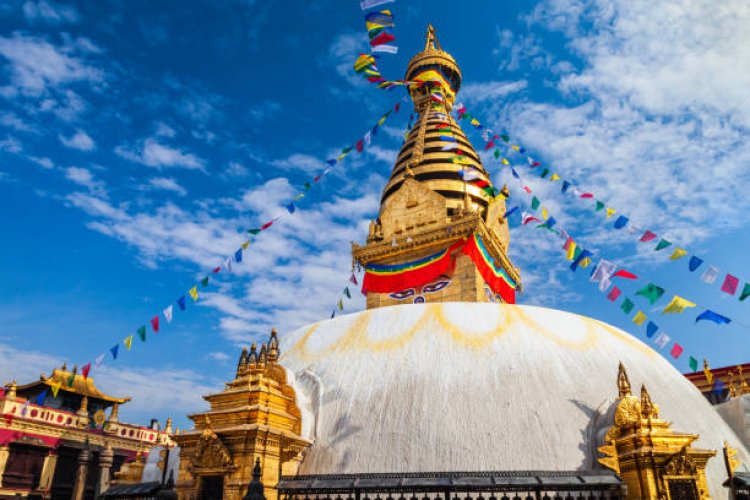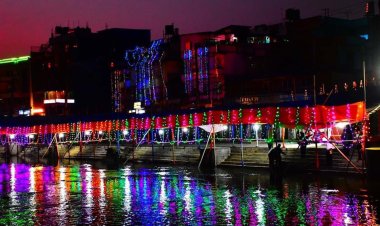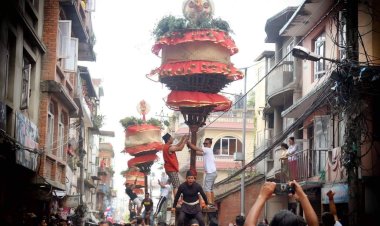Boudhanath Stupa: A Spiritual and Cultural Icon
Discover the spiritual and cultural significance of Boudhanath Stupa, a UNESCO World Heritage Site in Nepal.

Nestled in the bustling city of Kathmandu, Nepal, Boudhanath Stupa is one of the most revered and iconic landmarks of the country. Also known as the Boudha Stupa or the Great Stupa, this magnificent structure is a UNESCO World Heritage Site and a significant center of Buddhist culture and spirituality. Here's a closer look at the spiritual and cultural significance of Boudhanath Stupa:
The History of Boudhanath Stupa
Boudhanath Stupa was built in the 14th century by the Malla king, Ananda Malla. The stupa is said to be built on a sacred site where the remains of Kassapa Buddha were interred. Legend has it that the king was inspired to build the stupa after a dream in which he saw the shape of the stupa. The stupa has undergone several rounds of restoration and reconstruction over the centuries, with the most recent following the 2015 earthquake in Nepal. Despite these changes, the stupa remains an important site for Buddhists around the world and a symbol of Nepal's cultural heritage.
The Design and Architecture of Boudhanath Stupa
The design and architecture of Boudhanath Stupa are unique and have a rich symbolism in Buddhist tradition. Here are some key points about its design and architecture:
- The stupa is a spherical structure that stands at a height of 36 meters and has a diameter of 120 meters. Its white dome-shaped structure is adorned with a golden spire at the top.
- The base of the stupa is surrounded by 147 small niches, each with a statue of Buddha and inscriptions of mantras. The niches are decorated with colorful prayer flags that flutter in the breeze.
- The stupa has four pairs of eyes, which symbolize the omnipresence of Buddha and his ability to see in all directions. The eyes are painted in vivid colors of blue, white, red, and gold and are surrounded by a third eye painted in black.
- The stupa is also decorated with 108 small images of Buddha, which represent the 108 worldly desires that one must overcome to achieve enlightenment.
- There are numerous prayer wheels around the stupa that pilgrims spin while walking clockwise around the stupa. The spinning of the prayer wheels is believed to have the same effect as reciting the mantras contained within them.
Overall, the design and architecture of Boudhanath Stupa are a unique blend of ancient Buddhist traditions and Nepalese craftsmanship. The stupa's grandeur and symbolism have made it one of the most revered and iconic landmarks of Nepal.
The Spiritual Significance of Boudhanath Stupa
The Boudhanath Stupa is not just a cultural icon but also a spiritual destination for millions of Buddhists around the world. Here are some of the spiritual significance of the Boudhanath Stupa:
-
A pilgrimage site:
The Boudhanath Stupa is considered one of the most important pilgrimage sites for Buddhists. Every year, thousands of pilgrims from around the world come to visit the stupa, circumambulate it and offer their prayers and wishes. -
A symbol of the Buddha's teachings:
The Boudhanath Stupa is considered a symbol of the Buddha's teachings and a representation of the Buddhist world. The stupa's spherical shape represents the universe and the spire represents the path to enlightenment. -
A center of meditation and mindfulness:
The stupa is a place of meditation and mindfulness for Buddhists. Many come to the stupa to practice meditation, recite mantras or just sit in contemplation and reflect on their lives. -
A place of healing:
Many people believe that the stupa has healing properties and can help to heal physical and emotional wounds. It is not uncommon to see people circling the stupa with a prayer wheel, reciting mantras or lighting candles and incense in hopes of healing. -
A symbol of peace and harmony:
The Boudhanath Stupa is also considered a symbol of peace and harmony. It is a place where people of different cultures and religions come together to offer their prayers and share their love and compassion. -
A representation of the Three Jewels of Buddhism:
The Boudhanath Stupa is seen as a representation of the Three Jewels of Buddhism: the Buddha, the Dharma (the Buddha's teachings), and the Sangha (the Buddhist community). -
A place to make merit:
Making merit is an important practice in Buddhism, and the Boudhanath Stupa is considered a powerful place to do so. Many Buddhists come to the stupa to make offerings, give alms to the monks, or make donations to support the upkeep of the stupa and the surrounding monasteries and temples. -
A source of blessings:
The Boudhanath Stupa is believed to be a source of blessings for all those who visit it. Many Buddhists believe that by circumambulating the stupa, reciting mantras, and making offerings, they will receive blessings that will help them on their spiritual path and in their daily lives. -
A place of pilgrimage for Tibetans:
The Boudhanath Stupa is an important pilgrimage site for Tibetan Buddhists, many of whom fled to Nepal after the Chinese occupation of Tibet in 1959. The stupa is home to several monasteries and temples that serve as centers of Tibetan culture and learning. -
A reminder of impermanence:
The Boudhanath Stupa serves as a reminder of the Buddhist concept of impermanence. The stupa has undergone numerous reconstructions and renovations over the centuries, and it was severely damaged in the 2015 earthquake. Despite these changes, the stupa remains a powerful symbol of Buddhism and a testament to the impermanence of all things.
Overall, the Boudhanath Stupa is a symbol of spiritual and cultural significance, and its legacy continues to inspire and bring people together from all over the world.
The Cultural Importance of Boudhanath Stupa
Boudhanath Stupa is not only a significant spiritual site but also an important cultural landmark in Nepal. The cultural importance of Boudhanath Stupa can be attributed to several reasons:
-
Religious significance:
Boudhanath Stupa is a sacred site for Buddhists, and it is considered one of the most important pilgrimage sites in the world. The stupa is believed to contain the remains of Kassapa Buddha, and it is considered a place of great spiritual significance. -
Architectural significance:
The stupa is a magnificent architectural marvel and it is considered a masterpiece of Buddhist architecture. The stupa is built in the shape of a mandala, and it is adorned with intricate carvings and colorful prayer flags. -
Social significance:
Boudhanath Stupa is a hub of social activity and it is a place where people come to pray, meditate, and socialize. The stupa is surrounded by a bustling marketplace, and it is a popular destination for tourists and locals alike. -
Historical significance:
The stupa has a rich history, and it has survived several earthquakes and other disasters over the years. The stupa was originally built in the 5th century, and it has been an important cultural site for over a thousand years.
Overall, Boudhanath Stupa is a cultural treasure, and it is an indication of the rich cultural heritage of Nepal. The stupa is a place of great spiritual significance, and it is a symbol of peace, harmony, and unity. It is no wonder that the stupa is considered one of the most important cultural sites in the world.
In conclusion, Boudhanath Stupa is a spiritual and cultural icon that is an important site for Buddhists around the world and a symbol of Nepal's rich cultural heritage. Its unique design, spiritual significance, and cultural importance make it a must-visit landmark for anyone traveling to Nepal.
What's Your Reaction?





































































































